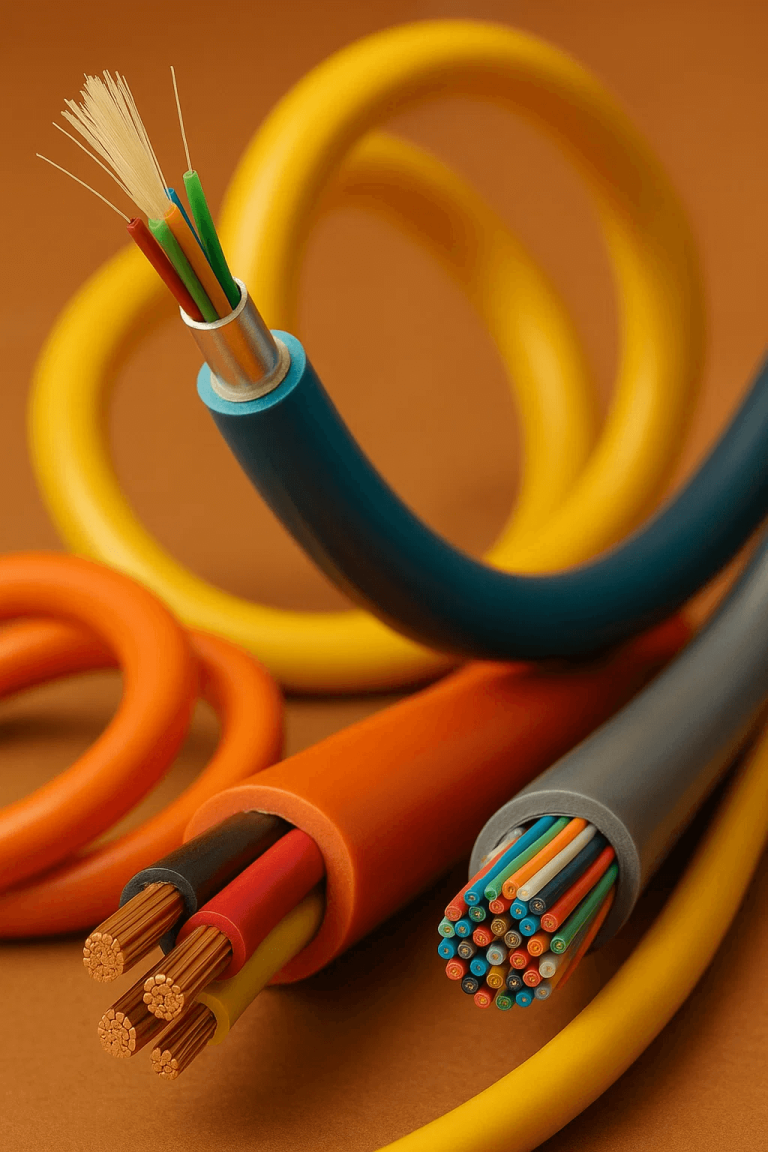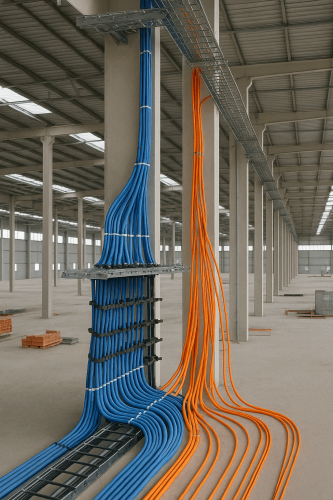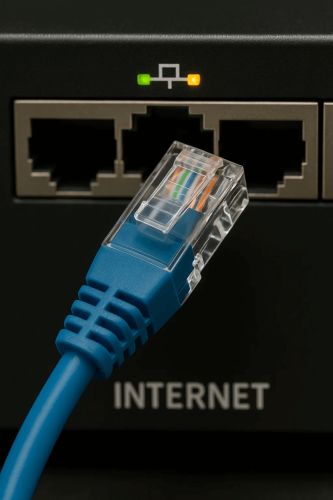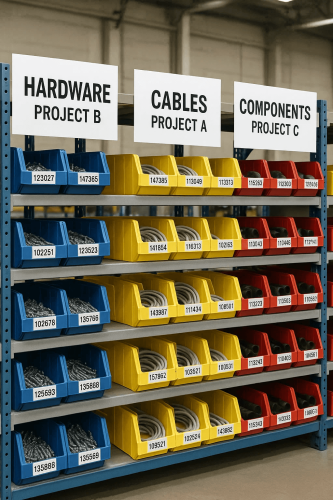Building a Smarter Network: Why Low Voltage Cabling is the Hidden Backbone of Modern Business
A Strong Network Foundation begins with Layer 1: Why Low Voltage Cabling is the Hidden Backbone of Modern Business
Think cables are just cables? Think again.
From crystal-clear video calls to fast file transfers and secure backups, low-voltage cabling powers the tools your business relies on every day. And yet, it’s often overlooked until a problem arises.
Let’s pull back the ceiling tiles and see why expertly engineered, designed, installed, and project-managed end-to-end cabling infrastructure makes all the difference. Whether you are a business owner, a business operator, or an architect, engineering details can either make or break (if overlooked) the implementation and the successful launch of your project.

Project Management: From Planning to Punch List

No guessing. No delays. No loose ends.
Enterprise-certified engineers and project managers help communicate the organization’s objectives, timelines, and oversee every stage of your cabling deployment:
• Scope definition and timeline alignment
• Budgeting, hardware sourcing, and competitive quotes
• Collaboration with construction and IT teams
• Progress tracking and on-site quality control
A well-organized network project can ensure the entire project runs smoothly, without disrupting your operations. However, vital engineering design flaws can potentially ruin reputations.
We suggest working with a technical company that has dedicated enterprise-certified network engineers and project coordinators.
Design & Recommendations: Tailored to Your Space
Good cabling starts with thoughtful planning.
Not all low-voltage designs are equal. Enterprise-certified network engineers can accurately assess client facilities, client requirements, and goals to engineer a system that’s both high-performing, sustainable, and future-ready:
• Determining ideal hardware and materials
• Space optimization for racks, panels, and cable pathways
• Determining the ideal locations for network components
• Efficient engineering, reducing hardware and materials
• Load forecasting for bandwidth and device growth
• Organization, labeling, and validation of work
From office buildings to large campuses, choose a design that is scalable and efficient.


CAT6 & CAT6A: The standard for most businesses
Reliable speed today—capacity for tomorrow.
CAT5/CAT5E cables are not capable of supporting current bandwidth requirements, resulting in limitations to the delivery of technology stacks.
• CAT6 cables use the same number of copper wires (eight) as CAT5/CAT5E; however, CAT6 cables are slightly thicker and can support 250MHz up to 10Gbps on distances up to 50 feet, or 1Gbps up to 300 feet. CAT6 is more malleable, making it easy to install and shape, and has minimal crosstalk, making it ideal for most business installations with desktops and VoIP applications.
• CAT6A cables use the same number of copper wires (eight) as CAT6; however, CAT6A cables are thicker and can support 500MHz, double that of CAT6, with speeds supporting up to 10 Gbps and distances within 150 feet, making them the go-to for dense or high-performance setups, typically within server rooms used for trunking high bandwidth devices. CAT6A is more costly, thicker, and less flexible than Cat6, which can make installation more challenging, requiring more labor and costs.
Regardless of the cable type, we recommend that the cabling vendor certify every line after installation to ensure there are no faults, cuts, or poor installations that could result in the need to pull new cable after all the new construction has been completed.
Ultra high speed: SMF, MMF & DAC
Need speed and distance? Fiber delivers.
• Single-mode fiber (SMF) is built from glass or plastic and is capable of supporting speeds up to 100Gbps and beyond, depending on the transceiver limitations. All fiber is sensitive to touch, dirt, and damage, and should be installed with care. SMF is used for long distances—ideal for inter-building connections and is the Telecom carriers’ preferred hand-off media type.
• Multi-mode fiber (MMF), like SMF, MMF, is also capable of supporting speeds up to 100Gbps and beyond, depending on the distance of the fiber run and transceiver limitations. MMF is distance sensitive, for example:
- 100 Mbit/s: Up to 2 kilometers.
- 1 Gbit/s: Up to 1000 meters.
- 10 Gbit/s: Up to 550 meters (OM4).
- 40/100 Gbps: Achievable over 150 meters using OM5 fiber and Short Wavelength Division Multiplexing (SWDM).
- 100 Gbps: Up to 70 meters with OM3, and 150 meters with OM4
All fiber is sensitive to touch, dirt, and damage, and should be installed with care. MMF can be a more cost-effective solution for shorter runs, like floor-to-floor links.
Fiber Types:
. OM1, OM2, OM3, OM4, and OM5 are different multimode fiber types, each with varying bandwidth and distance capabilities.
• Direct Access Copper (DAC) DAC cables are short-distance, copper-based cables that can be ordered with SFPs already connected, making it easier for technicians to install and move cables around. DAC cables are typically used for distances of up to 15 feet and can deliver speeds of up to 10Gbps. DAC cables are commonly used in server rooms with a high density of hardware, requiring high bandwidth capabilities.
Regardless of the ultra-high-speed cable type, we recommend that the cabling vendor certify every line after installation to ensure there are no faults, cuts, or poor installations that could result in the need to pull new cable after all the new construction has been completed.
Choosing the right team to engineer and design builds ensures your low-voltage, high-speed, and availability solution is sized right, terminated cleanly, and tested thoroughly.


Proofing & Testing: Verify, verify, verify
Performance you can prove.
Every cable should be rigorously tested to meet or exceed TIA and IEEE standards, which include:
- Evaluating signal loss, crosstalk, length, and continuity
- Confirming distance and speed capability
- Obtaining Fluke certification, where applicable
- Providing detailed reports for compliance and documentation
Regardless of the cable type, we recommend that the cabling vendor certify each line after it has been installed. This ensures that there are no faults, cuts, or installation issues that could necessitate pulling new cable once the construction is completed.
Labeling & Organization: Smart Now, Simple Later
A clean rack is a happy rack. An organized and clearly labeled cabling system and equipment rack facilitate easier maintenance and expansion. Key practices include:
- Using color-coded cables and ports
- Labeling jacks, patch panels, and terminations
- Implementing full rack numbering, documentation, and diagrams
These practices minimize troubleshooting time and ensure fast, efficient upgrades in the future.
Racks are available in various sizes:
- 6U, 9U, and 12U: Standard sizes for small networks or rooms, typically used for network hardware only, including intermediate distribution frames (IDFs).
- 20U: Half rack size, commonly used for small networks that require one or two servers, networking hardware, and cable management.
- 42U: Full rack size, ideal for multiple servers, networks, larger office buildings, and data centers.

Low Voltage Cabling Services in Los Angeles
There’s only one clear choice for low-voltage cabling in Los Angeles, Orange and Riverside counties.
Global IT provides expert cabling installation, fiber optic solutions, and CAT6 wiring across LA, including Downtown Los Angeles, Burbank, Glendale, Culver City, and the greater metro area, Riverside, Orange County, and San Diego.
Whether you’re renovating a workspace or building out a new facility, Global IT ensures your infrastructure is code-compliant, professionally tested, and built to scale. Have confidence in trusting an enterprise and local team with decades of experience in low-voltage cabling for Los Angeles, Orange, and Riverside counties.
Ready to Future-Proof Your Network?
Your cabling may be behind the scenes—but its impact is front and center. Let’s make sure it’s done right. Contact us today to discuss your low-voltage project in Los Angeles or nationwide.

